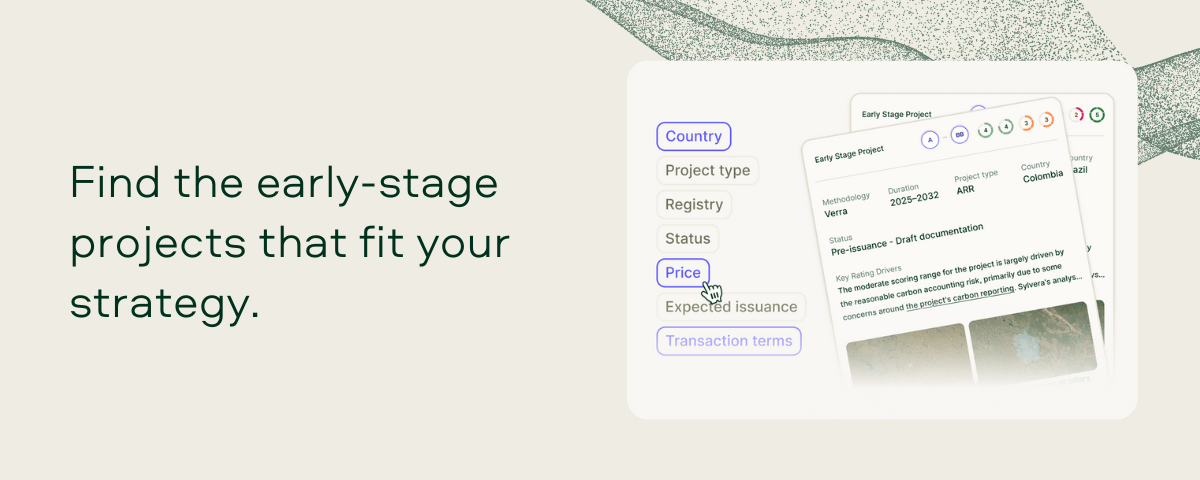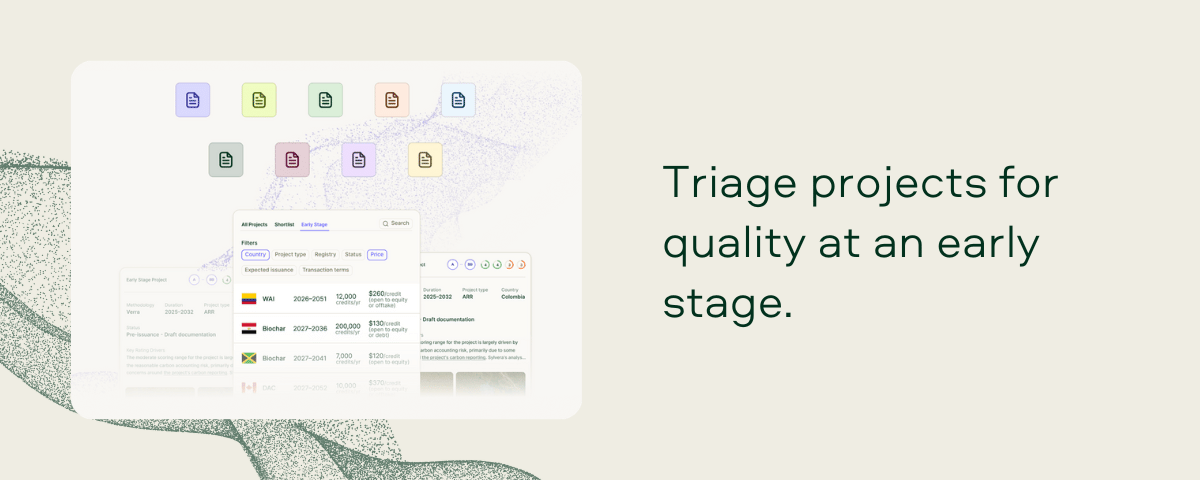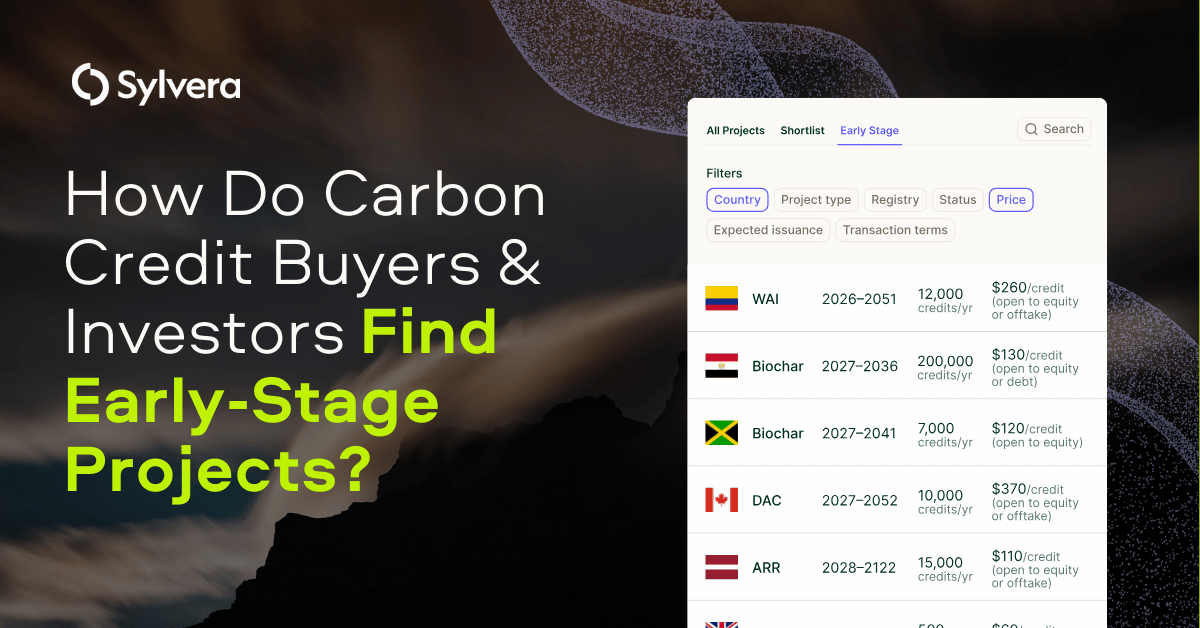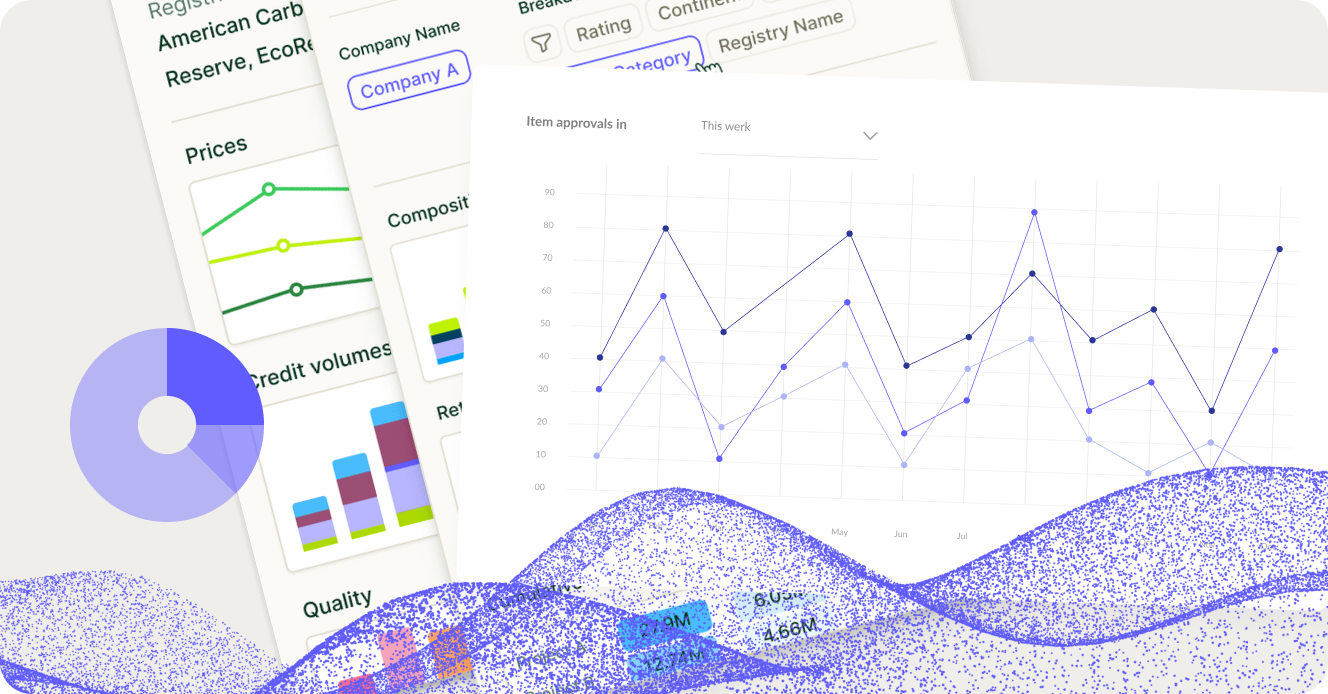"A lo largo de los años hemos invertido mucho en nuestro equipo de datos de campo, centrándonos en la elaboración de calificaciones fiables. Si bien esto garantiza la precisión de nuestras valoraciones, no permite la escala a través de los miles de proyectos que los compradores están considerando."
Para más información sobre las tendencias en la adquisición de créditos de carbono, lea nuestro artículo"Key Takeaways for 2025". Compartimos cinco consejos basados en datos para mejorar su estrategia de adquisición.

Una cosa más: los clientes de Connect to Supply también tienen acceso al resto de herramientas de Sylvera. Esto significa que puede ver fácilmente las calificaciones de los proyectos y evaluar los puntos fuertes de cada uno de ellos, obtener créditos de carbono de calidad e incluso supervisar la actividad del proyecto (sobre todo si ha invertido en la fase previa a la emisión).
Reserve una demostración gratuita de Sylvera para ver en acción las funciones de adquisición y elaboración de informes de nuestra plataforma.
El mercado del carbono está avanzando. Las empresas compradoras y los inversores climáticos ya no se conforman con esperar a que se emitan los créditos para tomar decisiones de compra.
En su lugar, buscan cada vez más oportunidades de inversión en fases tempranas que les permitan asegurar el suministro futuro, obtener mejores precios y dar forma al desarrollo de proyectos de alta integridad desde el principio.
Pero encontrar proyectos de carbono de calidad en fase inicial -también conocidos como pre-emisión o ex-ante- es fundamentalmente diferente de encontrar créditos emitidos. A diferencia de los registros establecidos que enumeran los créditos emitidos, no existe un mercado centralizado para las oportunidades de preemisión.
Esto crea un panorama fragmentado en el que los compradores deben navegar por innumerables relaciones individuales, información dispersa y una gran incertidumbre sobre la calidad de los proyectos. Y todo ello mientras compiten por acceder a los proyectos más prometedores en fase inicial.
Por eso hemos introducido el catálogo de proyectos en fase inicial de Sylvera, que forma parte de nuestra solución más amplia de preaseguramiento, para simplificar y agilizar la búsqueda de proyectos en fase inicial por parte de compradores e inversores.
El enfoque tradicional para encontrar proyectos de carbono en fase inicial
Hasta ahora, la mayoría de los compradores e inversores de créditos de carbono encontraban proyectos en fase inicial a través de un mosaico de enfoques, cada uno de ellos con importantes limitaciones.
El contacto directo con los promotores de proyectos requiere una amplia red de contactos y a menudo arroja información incompleta.
Las conferencias y eventos del sector brindan oportunidades para establecer contactos, pero ofrecen una cobertura sistemática limitada de los proyectos disponibles.
Las relaciones con corredores e intermediarios pueden facilitar el acceso, pero a menudo conllevan costes añadidos y posibles conflictos de intereses.
El enfoque más habitual consiste en ponerse en contacto individualmente con varios promotores de proyectos, solicitando información a través de procesos independientes para cada oportunidad potencial. Esto significa que los compradores deben rellenar numerosas solicitudes de información individuales, cada una con formatos y requisitos diferentes, lo que dificulta la comparación sistemática de oportunidades.
Este enfoque fragmentado crea varios problemas a los compradores. El proceso de identificación, evaluación y comparación de proyectos entre distintos promotores y regiones lleva mucho tiempo. Además, la visibilidad o documentación de las oportunidades disponibles es limitada, lo que significa que los compradores pueden pasar por alto proyectos prometedores simplemente porque no saben que existen.
Y, lo que quizá sea más importante, a menudo no se dispone de datos suficientes para evaluar la calidad de los proyectos antes de su emisión ni para clasificar las inversiones potenciales en esta fase.
Por qué es importante invertir en proyectos de carbono en su fase inicial
El cambio hacia la inversión en fases tempranas no se debe únicamente a la obtención de mejores precios, aunque las ventajas de coste son sin duda parte del atractivo.
Garantizar un suministro de créditos de carbono de calidad
Los equipos de sostenibilidad de las empresas están sometidos a una presión cada vez mayor para conseguir créditos de carbono fiables y de alta calidad que les permitan cumplir sus ambiciosos compromisos de emisiones netas cero. Esperar a que se emitan los créditos suele suponer competir por una oferta limitada de los proyectos de mayor calidad, lo que puede comprometer el precio o la integridad.
Garantizar y mejorar la integridad en una fase temprana
La inversión en fases tempranas también permite a los compradores influir en el desarrollo del proyecto de forma que se ajuste a sus requisitos y valores específicos. Al colaborar con los promotores durante las fases de planificación y desarrollo, los compradores pueden contribuir a garantizar que los proyectos cumplan sus normas de calidad, plazos y prioridades en materia de beneficios colaterales.
Financiación del desarrollo de proyectos
Y, para los inversores, los proyectos de carbono en fase inicial representan una forma de destinar capital a soluciones climáticas al tiempo que pueden generar rendimientos atractivos. Estas inversiones pueden adoptar múltiples formas: desde acuerdos de compra anticipada que garantizan créditos futuros a precios favorables hasta inversiones de capital en empresas de desarrollo de proyectos o financiación de deuda que permite la construcción de proyectos.
¿Quiere entender los proyectos de carbono en fase inicial? Nuestro manual contiene la información clave que necesita saber.

Presentamos una forma mejor de encontrar proyectos en fase inicial: Catálogo de proyectos en fase inicial de Sylvera
El Catálogo de Etapas Tempranas de Sylvera cambia radicalmente la forma en que los compradores e inversores descubren y clasifican las oportunidades de proyectos de carbono en etapas tempranas.
En lugar de navegar por un panorama fragmentado de relaciones individuales con desarrolladores, la plataforma ofrece un único punto de acceso a más de 250 proyectos en fase inicial de más de 200 proveedores y desarrolladores.
El catálogo aborda las ineficiencias del descubrimiento tradicional de proyectos en fase inicial reuniendo las oportunidades en una plataforma de búsqueda. Los compradores pueden utilizar opciones de filtrado avanzadas para identificar proyectos que se ajusten a sus criterios de inversión específicos, incluidas las condiciones de la transacción, las expectativas de precios, las preferencias geográficas y los plazos de emisión previstos.
Esto ahorra a compradores e inversores un tiempo y una complejidad considerables que, de otro modo, se dedicarían a la divulgación y la recopilación de información. En lugar de gestionar las relaciones con docenas de promotores individuales, puede evaluar eficazmente las oportunidades en todo el panorama de proyectos en fase inicial.

Cómo evaluar la calidad de los proyectos en una fase temprana
Aunque el descubrimiento centralizado resuelve el problema de la visibilidad, no aborda el reto fundamental de evaluar la calidad del proyecto antes de que se emitan los créditos. Aquí es donde la capacidad de Sylvera de realizar calificaciones estimadas resulta crucial para la toma de decisiones en las primeras fases.
Las calificaciones estimadas -disponibles dentro del Catálogo de Etapas Tempranas- aplican los marcos analíticos de Sylvera a los proyectos previos a la emisión, proporcionando señales de calidad basadas en los mismos principios científicos que impulsan nuestras renombradas calificaciones posteriores a la emisión.
Evalúan los proyectos a través de los mismos cuatro pilares que definen las calificaciones globales de Sylvera: Contabilidad del carbono, adicionalidad, permanencia y beneficios colaterales.
Las calificaciones estimadas se presentan como intervalos y no como puntuaciones definitivas, lo que refleja la incertidumbre inherente a la evaluación previa a la emisión. Por ejemplo, un proyecto puede recibir una calificación estimada de A-BB, lo que indica que, basándose en la información disponible, es probable que el proyecto reciba una calificación en algún punto de ese rango una vez que se emitan los créditos y se complete una evaluación completa.
Casos prácticos: Descubrimiento de proyectos en fase inicial y diligencia debida
Acuerdos de compra anticipada y ERPA Los compradores corporativos pueden utilizar el Catálogo de Etapas Tempranas para identificar proyectos adecuados para Acuerdos de Pago por Reducción de Emisiones (ERPA) u otros acuerdos de compra anticipada. Las calificaciones estimadas proporcionan la garantía de calidad necesaria para comprometer capital en proyectos antes de que se emitan los créditos, ayudando a los compradores a asegurarse el suministro futuro de promotores creíbles.
Diversificación de la cartera y gestión del riesgo: Los inversores que construyen diversas carteras de créditos de carbono pueden utilizar el catálogo para identificar oportunidades a través de diferentes tipos de proyectos, geografías y plazos de desarrollo. Las calificaciones estimadas ayudan a cuantificar los riesgos relacionados con la calidad, lo que permite tomar decisiones más informadas sobre la construcción de carteras.
Desarrollo estratégico de proveedores: Los grandes compradores con importantes necesidades de créditos de carbono pueden utilizar el catálogo para identificar y entablar relaciones con promotores prometedores al principio del ciclo de vida del proyecto. Este enfoque permite a los compradores influir en el desarrollo de los proyectos al tiempo que se aseguran un acceso preferente al suministro futuro.

Simplificar la inversión inicial en carbono
A medida que madura el mercado voluntario del carbono, la capacidad de identificar y evaluar oportunidades antes de que se emitan los créditos es cada vez más importante para todos los participantes en el mercado.
Para los compradores corporativos, las capacidades de inversión en fases tempranas se están convirtiendo en esenciales para cumplir los ambiciosos compromisos climáticos al tiempo que se gestionan los costes y los riesgos de calidad. Para los inversores, las oportunidades previas a la emisión representan una clase de activos en expansión que combina la rentabilidad financiera con un impacto climático mensurable.
Al proporcionar un lugar único para el descubrimiento y la inteligencia de calidad creíble para los proyectos en fase inicial, Sylvera está ayudando a construir la infraestructura de mercado necesaria para canalizar más capital hacia soluciones climáticas de alta integridad.
Si desea ver el catálogo Early Stage en acción, reserve una demostración aquí.















